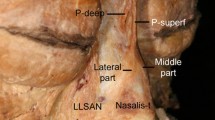Abstract
Purpose
The aim of this study was to determine the width of the fibers that extend from the orbicularis oculi muscle (OOc) to the upper lip, and the lateral and inferior lengths of the OOc at the lateral canthus level.
Methods
The OOc was investigated in the 40 hemifaces of 20 Korean cadavers. The lateral fibers of the OOc (OOc lat) were traced to determine whether or not these fibers extended to the upper lip.
Results
The OOc lat extended to the upper lip at the lateral canthus level in 31 of the 40 specimens (77.5%), whereas some inferolateral fibers of the OOc that extended to the upper lip were observed near the level of the lower margin of the OOc in the other 9 specimens (22.5%). The mean ± SD and maximum widths of the OOc lat that extended to the upper lip at the lateral canthus level were 6.9 ± 3.3 mm and 14.3 mm, respectively.
Conclusion
The obtained data will be helpful to distinguish the muscles that underly the wrinkles around the lateral canthus for safer and more-efficient BoNT-A treatments for crow’s feet.





Similar content being viewed by others
Data availability
The data that support the findings of this study are available from the corresponding author, Mi-Sun Hur, upon reasonable request.
References
Benedetto AV (2018) Botulinum toxins in clinical aesthetic practice, 3rd edn. CRC Press, New York
Carruthers A, Bruce S, Cox SE, Kane MA, Lee E, Gallagher CJ (2016) OnabotulinumtoxinA for treatment of moderate to severe crow’s feet lines: a review. Aesthet Surg J 36:591–597. https://doi.org/10.1093/asj/sjw025
Guerrissi JO (2000) Intraoperative injection of botulinum toxin A into orbicularis oculi muscle for the treatment of crow’s feet. Plast Reconstr Surg 105:2219–2225
Hur MS, Youn KH, Kim HJ (2018) New insight regarding the zygomaticus minor as related to cosmetic facial Injections. Clin Anat 31:974–980. https://doi.org/10.1002/ca.23272
Imhof M, Kuhne U (2013) Introduction of the microdroplet technique with incobotulinumtoxin a for the treatment of crow’s feet. J Clin Aesthet Dermatol 6:40–44
Iwanaga J, Singh V, Ohtsuka A, Hwang Y, Kim HJ, Moryś J et al (2021) Acknowledging the use of human cadaveric tissues in research papers: recommendations from anatomical journal editors. Clin Anat 34(1):2–4. https://doi.org/10.1002/ca.23671
Iwanaga J, Hur MS, Kikuta S, Ibaragi S, Watanabe K, Tubbs RS (2022) Anatomical contribution of the orbicularis oculi to the zygomaticus major: An improved understanding of the smile with consideration for facial cosmetic procedures. PLoS ONE 17:e0272060. https://doi.org/10.1371/journal.pone.0272060
Jin HR (2016) Aesthetic plastic surgery of the east Asian face. Thieme, New York
Kane MA (2003) Classification of crow’s feet patterns among Caucasian women: the key to individualizing treatment. Plast Reconstr Surg 112:33S-39S. https://doi.org/10.1097/01.PRS.0000082192.45787.B6
Kane MA, Cox SE, Jones D, Lei X, Gallagher CJ (2015) Heterogeneity of crow’s feet line patterns in clinical trial subjects. Dermatol Surg 41:447–456. https://doi.org/10.1097/DSS.0000000000000336
Kim HJ, Seo KK, Lee HK, Kim J (2016) Clinical anatomy of the face for filler and botulinum toxin Injection. Springer, Singapore
Matarasso SL, Matarasso A (2001) Treatment guidelines for botulinum toxin type A for the periocular region and a report on partial upper lip ptosis following injections to the lateral canthal rhytids. Plast Reconstr Surg 108:208–214. https://doi.org/10.1097/00006534-200107000-00033
Park DH, Han DG, Shim JS, Lee YJ, Park SU, Do ER, Choo KJ (2012) Analysis of the patterns of lateral canthal rhytids and reference for botulinum toxin treatment in orientals. Aesthetic Plast Surg 36:1211–1215. https://doi.org/10.1007/s00266-012-9932-z
Seo KK (2017) Botulinum toxin for Asians. Springer, Singapore
Vachiramon V, Subpayasarn U, Triyangkulsri K, Jurairattanaporn N, Rattananukrom T (2021) Different injection patterns of incobotulinumtoxinA for crow’s feet: a split-face comparative study. J Eur Acad Dermatol Venereol 35:256–262. https://doi.org/10.1111/jdv.16997
Yi KH, Lee JH, Kim GY, Yoon SW, Oh W, Kim HJ (2022) Novel anatomical proposal for botulinum neurotoxin injection targeting lateral canthal rhytids. Toxins 14(7):462. https://doi.org/10.3390/toxins14070462
Youn KH, Park JT, Park DS, Koh KS, Kim HJ, Paik DJ (2012) Morphology of the zygomaticus minor and its relationship with the orbicularis oculi muscle. J Craniofac Surg 23:546–548. https://doi.org/10.1097/SCS.0b013e31824190c3
Acknowledgements
The authors sincerely thank those who donated their bodies to science so that anatomical research could be performed. Results from such research can potentially increase mankind’s overall knowledge, which can then improve patient care. Therefore, these donors and their families deserve our highest gratitude [6].
Funding
This work was supported by a National Research Foundation of Korea (NRF) Grant funded by the Korean government (MSIT) (No.2020R1C1C1003237).
Author information
Authors and Affiliations
Contributions
MSH: project development, data collection, data analysis, manuscript writing, manuscript editing; JI: manuscript writing, manuscript editing; RST: manuscript writing, manuscript editing; YSM: manuscript writing, manuscript editing; HK: manuscript writing, manuscript editing. All authors have read and agreed to the published version of the manuscript.
Corresponding author
Ethics declarations
Conflict of interest
The authors declare no conflict of interest.
Ethical approval
This study was approved by the Institutional Review Board of the Catholic Kwandong University (IRB no. CKU-21-01-0603).
Consent to participate
This study was approved by the Institutional Review Board of the Catholic Kwandong University (IRB no. CKU-21-01-0603).
Consent for publication
All authors (MSH, JI, RST, YSM, HK) read the manuscript and have approved the content of the article and agree to present the article in "Surgical and Radiologic Anatomy" for publication.
Additional information
Publisher's Note
Springer Nature remains neutral with regard to jurisdictional claims in published maps and institutional affiliations.
Rights and permissions
Springer Nature or its licensor (e.g. a society or other partner) holds exclusive rights to this article under a publishing agreement with the author(s) or other rightsholder(s); author self-archiving of the accepted manuscript version of this article is solely governed by the terms of such publishing agreement and applicable law.
About this article
Cite this article
Hur, MS., Iwanaga, J., Tubbs, R.S. et al. Width of the orbicularis oculi fibers extending to the upper lip with the lateral and inferior lengths of the orbicularis oculi at the lateral canthus level: application to botulinum neurotoxin type A injection for crow’s feet. Surg Radiol Anat 45, 461–468 (2023). https://doi.org/10.1007/s00276-023-03103-0
Received:
Accepted:
Published:
Issue Date:
DOI: https://doi.org/10.1007/s00276-023-03103-0




